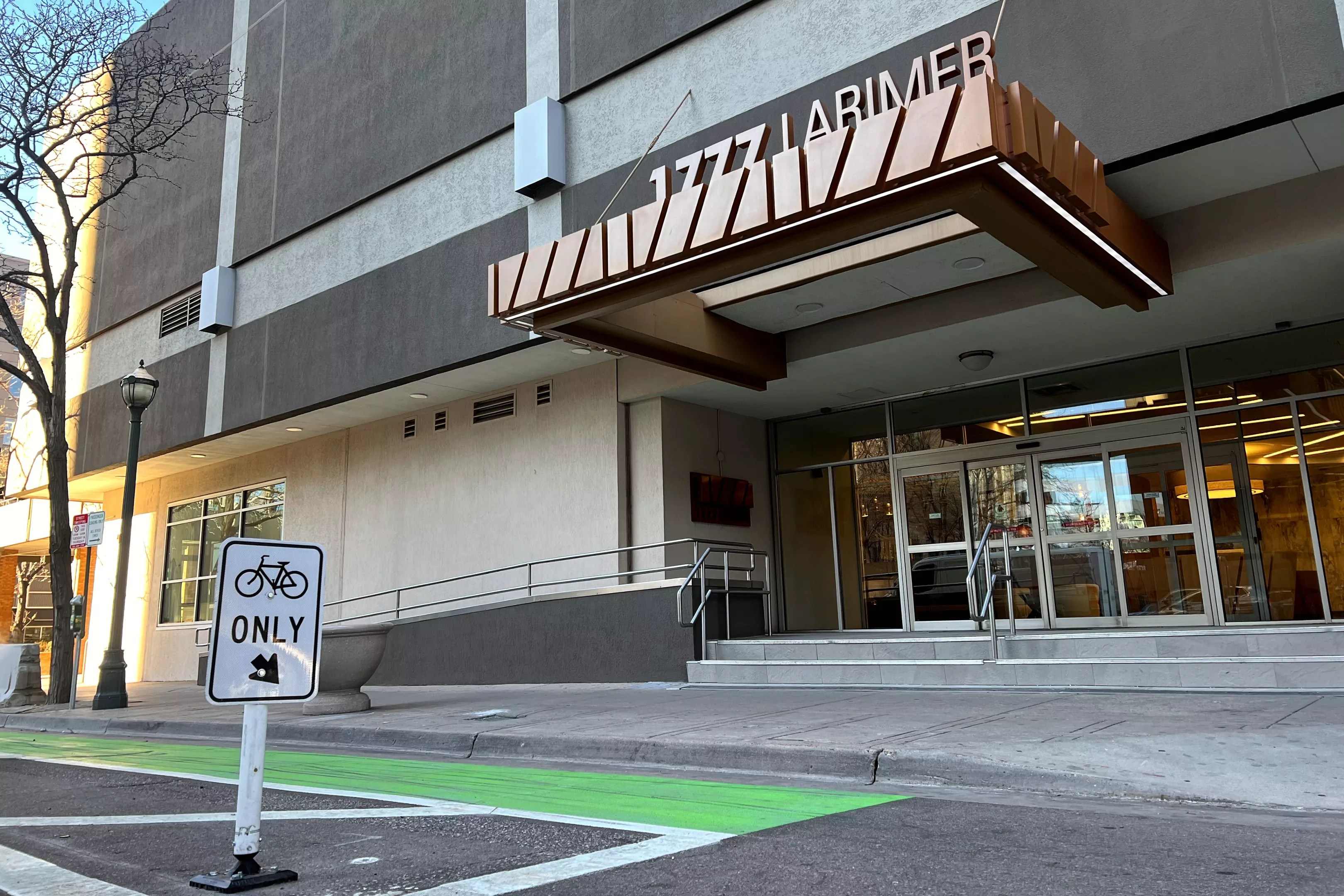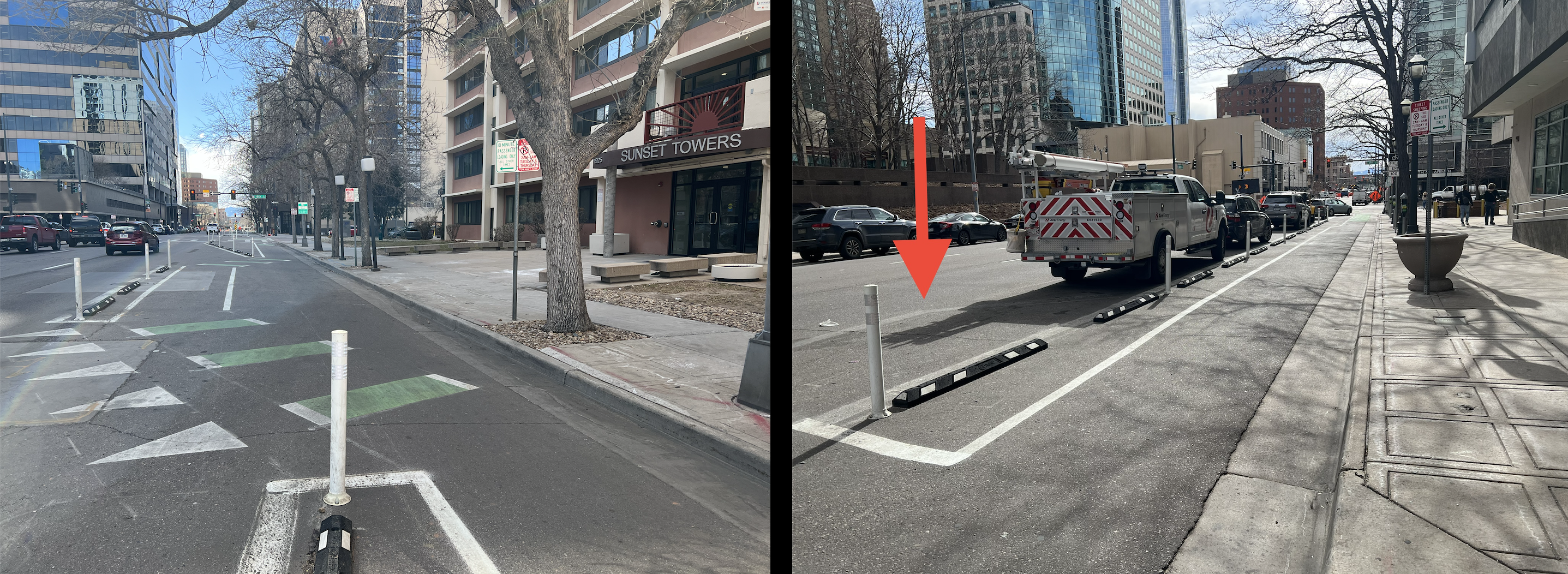
Hannah Metzger

Audio By Carbonatix
It has been one year since Bob Paolini tripped on the bike lane outside of his home at Denver’s Windsor Condominiums.
Residents had complained to the city for months before Paolini’s fall, arguing that the bike lane was a safety hazard. The lane, lined with posts and bumpers, separated the building at 1777 Larimer Street from the designated drop-off area, requiring people to cross it to reach the building’s entrance. At least half of Windsor’s 200-plus residents are senior citizens, many of whom cannot drive and rely on the drop-off zone.
Paolini, 82, tripped on one of the bumpers while exiting a vehicle in January 2024, falling backward onto the asphalt. He fractured his pelvis, and the injury led to two more falls in the following months. Paolini died from an infection in April a week after his last fall, leading some of his friends and neighbors to blame the bike lane for his death.
“Bob’s passing is directly a result of a bad policy that the city made,” Dave Mahler, a longtime friend of Paolini’s, told Westword in June. “Bob would still be here but for the bike lane.”
Paolini spoke to Westword advocating for changes to the bike lane two months before his death, saying he feared leaving his home. “I cannot fall again and go through this all over again,” he said.
After he passed, the city ultimately committed to adjusting the bike lane. Now, the changes have been made – but residents question whether they are enough.
Today, the bike lane outside of the Windsor is much different from when it was first installed in August 2023. The rubber bumpers and white posts that residents called a tripping hazard are gone. Green paint highlights the lane at the loading zone, which has been expanded from one parking space to two. And the lane is slightly narrower in front of the building to give passengers space to exit vehicles without stepping into the path of passing bikes and scooters.

The newly-adjusted bike lane outside of the Windsor Condominiums building.
Hannah Metzger
However, none of these changes are what the residents asked for. They want the same bike lane setup that’s outside the Sunset Towers senior living community, located just two blocks away on Larimer Street. At Sunset Towers, the bike lane bends around the building’s designated loading zone, so the loading zone is directly on the curb instead of being blocked by the bike lane.
But after more than a year of fighting, leadership at the Windsor Condominiums is ready to concede.
“We’ve done everything we can possibly do,” says Jack Walker, an 81-year-old who has lived in the building since 1995. “We’re disappointed they didn’t agree with us but there’s really nothing else we can do right now.”
Each of the changes to the bike lane happened gradually following months of pleading from the Windsor residents and even assistance from Denver City Council members. After Paolini’s death, the city agreed to remove the rubber bumpers that he tripped on, but initially said they wouldn’t take out the white posts. Even the original one-parking-space loading zone wasn’t put in until Windsor residents fought for it. But Walker says they’re done pushing, for now.
“We’re going to play the cards we’re dealt,” he says. “We’re going to see what happens.”
The city allowed a “non-standard design” for the bike lane outside of Sunset Towers because its loading zone receives more than two dozen pick-ups/drop-offs every day from RTD’s accessibility and senior ride services, each of which lasts several minutes, according to Nancy Kuhn, spokesperson for Denver’s Department of Transportation & Infrastructure. The same situation doesn’t apply to the Windsor, whose senior residents say they primarily rely on family, friends and ride-sharing apps to get around.

The Sunset Towers loading zone (left) and the original Windsor loading zone (right).
Hannah Metzger
Kuhn says the adjustments made to the Windsor’s bike lane have all been in response to feedback from residents. With so many changes made, the city is now focused on seeing what impact they have.
“DOTI will monitor the impact of these changes and the other changes that were made for a year,” Kuhn explains. “We typically do a review six months to a year after installation, looking at vehicle speeds, travel volumes, bicycle and scooter ridership and crash data and conducting periodic site visits during increased commuter timeframes.”
Walker says the Windsor will assist the city in monitoring the bike lane over the next year; they’re setting up a reporting system for residents and installing cameras outside the building.
“We want to be helpful,” he adds. “We want to be part of this plan.”
But concerns remain. While residents won’t deny the improvement, they say the changes primarily address the tripping hazard posed by the bike lane. Even without the bumpers and posts, residents still have to cross bike lane traffic to get from the loading zone to the building. Windsor leadership says they’ve received reports of “countless close calls” from residents narrowly dodging being struck by speeding bikes and e-scooters.
In addition, separating the loading from the curb creates accessibility issues for residents who use walkers and wheelchairs. Vehicle ramps cannot land directly on the sidewalk; instead, these residents must go down the bike lane and into the path of the parking garage exit to get to the nearest curb ramp. Or they must get dropped off at the handicapped parking space at the end of the block and travel uphill to the building, which can be strenuous for senior residents.
“It’s an improvement, but we’re not satisfied,” Walker says. “But we understand it and we are going to participate in helping monitor. We’re not the happiest about it, but we want to help.”
Walker hopes the changes will be enough. He fears they won’t be.
“It’s just a matter of time,” he warns. “We all think there’s going to be another accident at some point. Somebody’s going to get hurt big time. They don’t seem to be too concerned about that.”